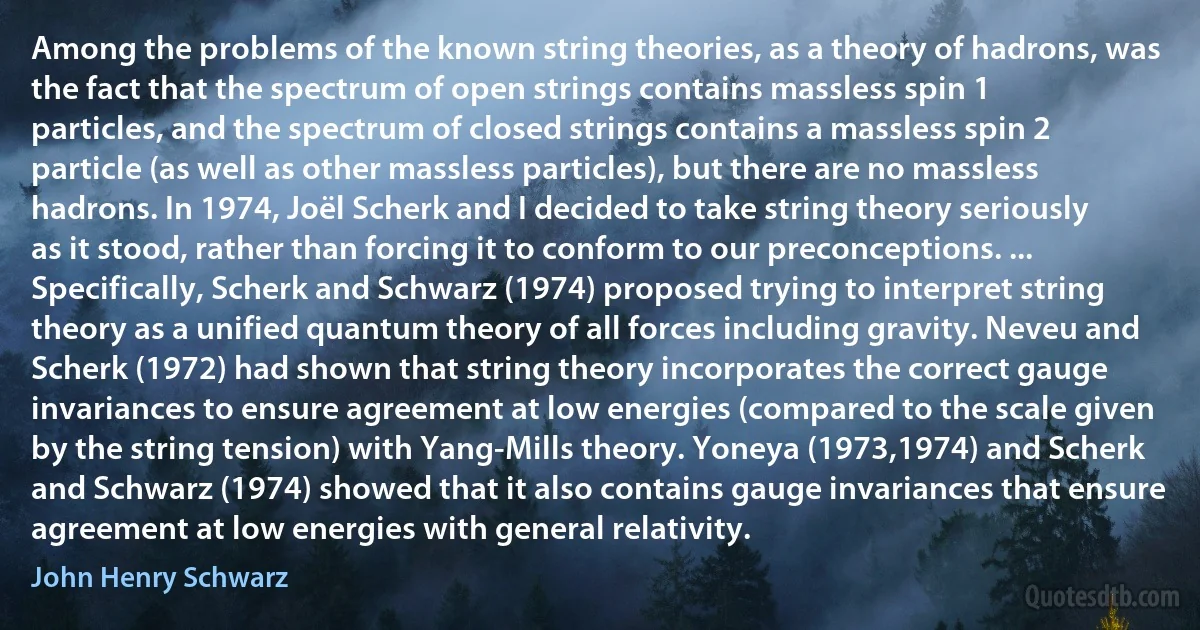
Among the problems of the known string theories, as a theory of hadrons, was the fact that the spectrum of open strings contains massless spin 1 particles, and the spectrum of closed strings contains a massless spin 2 particle (as well as other massless particles), but there are no massless hadrons. In 1974, Joël Scherk and I decided to take string theory seriously as it stood, rather than forcing it to conform to our preconceptions. ... Specifically, Scherk and Schwarz (1974) proposed trying to interpret string theory as a unified quantum theory of all forces including gravity. Neveu and Scherk (1972) had shown that string theory incorporates the correct gauge invariances to ensure agreement at low energies (compared to the scale given by the string tension) with Yang-Mills theory. Yoneya (1973,1974) and Scherk and Schwarz (1974) showed that it also contains gauge invariances that ensure agreement at low energies with general relativity.
John Henry SchwarzRelated topics
agreement correct general given known low open quantum relativity show spectrum spin stand string take tension trying well joelRelated quotes
Man may be excused for feeling some pride at having risen, though not through his own exertions, to the very summit of the organic scale; and the fact of his having thus risen, instead of having been aboriginally placed there, may give him hopes for a still higher destiny in the distant future. But we are not here concerned with hopes or fears, only with the truth as far as our reason allows us to discover it. I have given the evidence to the best of my ability; and we must acknowledge, as it seems to me, that man with all his noble qualities, with sympathy which feels for the most debased, with benevolence which extends not only to other men but to the humblest living creature, with his god-like intellect which has penetrated into the movements and constitution of the solar system - with all these exalted powers - Man still bears in his bodily frame the indelible stamp of his lowly origin.

Charles Darwin
[A] skyhook is ... an exception to the principle that all design, and apparent design, is ultimately the result of mindless, motiveless mechanicity. A crane, in contrast, is a subprocess or special feature of a design process that can be demonstrated to permit the local speeding up of the basic, slow process of natural selection, and that can be demonstrated to be itself the predictable (or retroactively explicable) product of the basic process. ... [T]he physicist Steven Weinberg, in Dreams of a Final Theory (1992) ... distinguishes between uncompromising reductionism (a bad thing) and compromising reductionism (which he ringingly endorses). Here is my own version. We must distinguish reductionism, which is in general a good thing, from greedy reductionism, which is not. The difference, in the context of Darwin's theory, is simple: greedy reductionists think that everything can be explained without cranes; good reductionists think that everything can be explained without skyhooks.

Daniel Dennett
It may be observed of mathematicians that they only meddle with such things as are certain, passing by those that are doubtful and unknown. They profess not to know all things, neither do they affect to speak of all things. What they know to be true, and can make good by invincible arguments, that they publish and insert among their theorems. Of other things they are silent and pass no judgment at all, choosing rather to acknowledge their ignorance, than affirm anything rashly. They affirm nothing among their arguments or assertions which is not most manifestly known and examined with utmost rigour, rejecting all probable conjectures and little witticisms. They submit nothing to authority, indulge no affection, detest subterfuges of words, and declare their sentiments, as in a court of justice, without passion, without apology; knowing that their reasons, as Seneca testifies of them, are not brought to persuade, but to compel.

Isaac Barrow
... It was (in part) Gross's excessive enthusiasm for string theory in the mid-80s that drove me (as an impressionable grad student at Princeton) away from theoretical physics (and into astronomy). String theory may have been a beautiful idea, but it made no predictions that could be tested experimentally in the then-foreseeable future. That's not science.
A quarter century later and the theoretical physics community has yet to wake up and realize that there is new physics right under their noses – just not the new physics they've been expecting (GUTs, strings, membranes, etc.). Galaxy dynamics are consistent with a single, universal force law, but this unexpected behavior has largely been ignored because it doesn't fit with particle theorists' dreams of super symmetric dark matter particles. That we do not understand the observed behavior makes it more interesting than the "expected” (but unobserved) new physics: who ordered this?

Stacy McGaugh
Here is my speech from the Brilliant Minds conference in Stockholm. Since I don't have the video yet, I'm sharing it like this. Around the year 2030, we will be in a position where we probably set off an irreversible chain reaction beyond human control, that will most likely lead to the end of our civilization as we know it. That is unless in that time, permanent and unprecedented changes in all aspects of industrialized society have taken place. Including a reduction of our CO2 emissions by at least 50%. And please note that these calculations are depending on inventions that have not yet been invented at scale. Furthermore these scientific calculations do not include most unforeseen tipping points and feed back loops. Nor do these calculations include already locked in warming hidden by toxic air pollution. Nor the aspect of equity, which is absolutely necessary to make the Paris Agreement work on a global scale. And these calculations are not opinions or wild guesses.

Greta Thunberg
